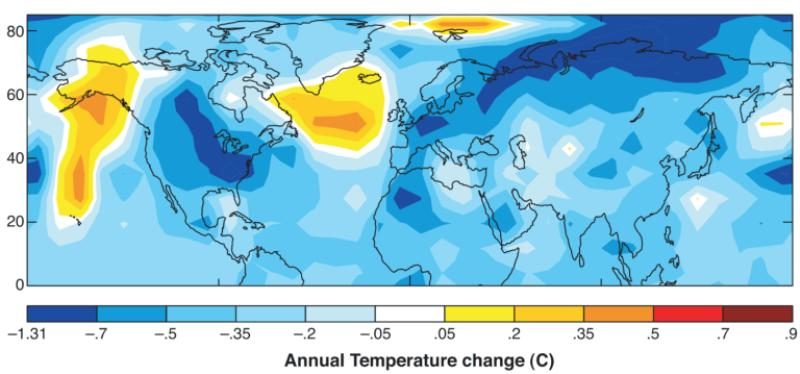Alert, Nunavut (located 900km from the North Pole)
broke temperature records over the weekend as a heatwave continued to both grip portions of the upper-most northern latitudes and send the biased MSM into another warm-mongering tizzy.The mercury topped out at 21C (69.8F) in Alert last Sunday, surpassing the previous record high for the settlement of 20C (68F) set in 1956 (
solar minimum of cycle 18) — which begs the obvious question,
if CO2 is driving temperatures to unprecedented highs then why the hell was it 20C in the Arctic in 1956, when levels were only 310 ppm?Breathe in... and out...
The media's latest heat-related tizzy comes fresh-on-the-heels of the Anchorage flap, when Alaska's largest city recorded 32C (90F) on July 4 which busted the all-time record high for the outlying state.
However, and in another attempt
by me to apply logic, what the mainstream media ALWAYS neglects to mention is all that
anomalous cold occurring
simultaneously further south.
For example, while Alert saw heat last weekend, vast regions to its south were experiencing markedly cooler than normal summer highs, with temperature departures as much as 16C below-average felt as far down as Louisiana and Mississippi:
GFS TEMP ANOMALIES for SUN, JULY 14:Rick Thoman, a climate
specialist at the University of Alaska, has gotten very excited regarding the recent warm weather up north, probably because it justifies his pay packet: "Surface temperatures are above normal everywhere around Alaska. The entire Gulf of Alaska, in the Bering Sea, in the Chukchi Sea south of the ice edge, exceptionally warm waters, warmest on record, and of course record-low sea ice extent for this time of year off the north and northwest coasts of the state."
But all that means nothing unless you look at things as a whole.
And the
whole would indicate a drastically different climate reality to one the MSM, UN and IPCC would have you believe. Because when you incorporate the sun into your models and forecasts (which the IPCC refuses to do) it is
instantly revealed that
natural global warming is over and the world is now once again cooling.
Perversely, a warming Arctic and Alaska serves as further evidence for this:
According to NASA,
some regions of the planet actually warmed during previous periods of global cooling (Alaska, the Arctic and the North Atlantic/southern Greenland being the largest of these), though the
averaged temperature increase wasn't enough to cause additional ice-melt, a rise from -34C to even -32C wouldn't, of course — whereas a decrease of 2C at the lower latitudes
would have a detrimental impact; driving glacial advance and increasing albedo while also devastating growing regions.

NASA — temp changes during the years 1680 (Maunder Minimum) and 1780 (‘normal’ solar activity)
Research (
Mikhaël Schwander, et al, 2017) has linked a
wavy jet stream to low solar activity.
During a solar minimum, the jet stream's usual Zonal Flow (a west-east direction) reverts to more of a Meridional Flow (a north-south direction) — this is exaggerated further during a Grand Solar Minimum, like the one we're entering now, and explains why regions become unseasonably hot or cold and others unusually dry or rainy, with the extremes lasting for an extended period of time.
It's this wavy flow that is responsible for the lower-latitudes experiencing record low temperatures of late as much as it is the higher-latitudes breaking record high ones.And, again according to NASA, the sun is now entering its weakest solar cycle of the past 200 years:
The upshot of which will be increasing departures from the norm including much colder, harsher winters and shortened growing seasons at earth's lower latitudes (where us humans reside).
Warmth is beneficial for life, how the media has convinced people otherwise is baffling, and dangerous.
The cold times are returning and they're bringing crop failure and famine along with them.
In fact, the
United States just suffered it's coldest October to May in recorded history and as a result is experiencing
it's slowest planting season on record, and the story is similar across the globe.
It's beginning.
The time to prepare is now.
Grow your own.
Comment: With the wandering poles, a significant weakening of Earth's magnetic field and cosmic rays rising for the fourth consecutive year, scientists are predicting that a geomagnetic shift is in process. At the same time we're seeing more extreme weather events, as well as an overall drop in temperatures around the globe, incredible hail storms, along with a variety of other unusual phenomena.
- Professor Zharkova's Grand Solar Minimum 2020 - 2055 paper accepted by Nature - 300 years of warming from 2370
- A Global Food Disaster is in The Making
- NASA predicts weakest solar activity in 200 years
- Adapt 2030 Ice Age Report: Global volcanic feedback loop now causing unusual cold temperatures
- Study: Cosmic rays trigger climate change on Earth by increasing cloud cover
- Is there a connection between cosmic rays, earthquakes and volcanic eruptions?
Also check out SOTT radio's: Behind the Headlines: Earth changes in an electric universe: Is climate change really man-made?